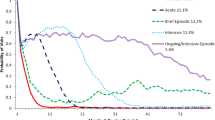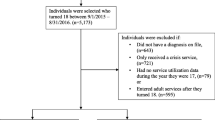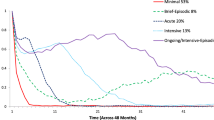Abstract
This study examines rates of admission and patterns of mental health service use by persons of transition age (16–25 years) in the USA based on the nationally representative 1997 Client/Patient Sample Survey and population data from the US Census Bureau. A precipitous decline in utilization was observed at the age of emancipation: the yearly admission rate for inpatient, outpatient, and residential services was 34 per 1,000 for 16- and 17-year-olds and 18 per 1,000 for 18- and 19-year-olds. Among 20- and 21-year-olds, more were referred from criminal justice and fewer from family or friends and social services, and proportionately more were Medicaid recipients. Targeting resources to enhance shared planning between child and adult systems may facilitate continuity of care for young adult clients who are aging out of child mental health systems, as well as for those who experience their first episodes of mental disorder in early adulthood.

Similar content being viewed by others
References
Clark HB, Davis M, eds. Transition to Adulthood: A Resource for Assisting Young People with Emotional or Behavioral Difficulties. Baltimore: Brookes; 2000.
Davis M, Sondheimer DL. State child mental health efforts to support youth in transition to adulthood. Journal of Behavioral Health Services and Research. 2005;32(1):27–42.
Davis M, Vander Stoep A. The transition to adulthood for youth who have serious emotional disturbance: Developmental transition and young adult outcomes. Journal of Mental Health Administration. 1997;24(4):400–427.
Davis M, Banks S, Fisher W, et al. Longitudinal patterns of offending during the transition to adulthood in youth from the mental health system. Journal of Behavioral Health Services and Research. 2004;31(4):351–366.
Vander Stoep A, Beresford SA, Weiss NS, et al. Community-based study of the transition to adulthood for adolescents with psychiatric disorder. American Journal of Epidemiology. 2000;152:352–362.
Costello EJ, Angold A, Burns B, et al. The Great Smoky Mountains study of youth: Functional impairment and serious emotional disturbance. Archives of General Psychiatry. 1996;53:1137–1143.
Cohen P, Cohen T, Kasen S, et al. An epidemiological study of disorders in late adolescence and adolescence: I: Age- and gender-specific prevalence. Journal of Child Psychology and Psychiatry. 1993;34:851–867.
Leaf PJ, Alegria M, Cohen P, et al. Mental health service use in the community and schools: Results from the four-community MECA study. Journal of the American Academy of Child and Adolescent Psychiatry. 1996;35:889–897.
Kessler RC. The National Comorbidity Survey of the United States. International Review of Psychiatry. 1994;6(4):365–376.
Kessler RC. Building on the ECA: The National Comorbidity Survey and the Children’s ECA. International Journal of Methods in Psychiatric Research. 1994;4(2):81–94.
Kessler RC, Berglund P, Demler O, et al. Lifetime prevalence and age-of-onset distributions of DSM-IV disorders in the National Comorbidity Survey Replication. Archives of General Psychiatry. 2005;62(6):593–603.
Mrazek PJ, Haggerty RJ, eds. Reducing Risks for Mental Disorders: Frontiers for Preventive Intervention Research. Washington, DC: National Academy Press; 1994.
Davis M, Koroloff N. The great divide: How public mental health policy fails young adults. In: Fisher WH, ed. Community Based Mental Health Services for Children and Adolescent. Oxford: Elsevier Sciences; 2006:53–74.
Newman DL, Moffitt TE, Caspi A, et al. Psychiatric disorder in a birth cohort of young adults: Prevalence, comorbidity, clinical significance, and new case incidence from ages 11 to 21. Journal of Consulting and Clinical Psychology. 1996;64(3):552–562.
Kim-Cohen J, Caspi A, Moffitt TE, et al. Prior juvenile diagnoses in adults with mental disorder: Developmental follow-back of a prospective-longitudinal cohort. Archives of General Psychiatry. 2003;60(7):709–717.
Substance Abuse and Mental Health Services Administration. Results from the 2004 National Survey on Drug Use and Health: National Findings (Office of Applied Studies, NSDUH Series H-28, DHHS Publication No. SMA 05-4062). Rockville: Substance Abuse and Mental Health Services Administration; 2005
Murray RM, van Os J. Predictors of outcome in schizophrenia. Journal of Clinical Psychopharmacology. 1998;18:2S–4S.
Beiser M, Erickson D, Fleming UF, et al. Establishing the onset of psychotic illness. American Journal of Psychiatry. 1993;150:1349–1354.
Silver S, Duchnowski A, Kutash K, et al. A comparison of children with serious emotional disturbance served in residential and school settings. Journal of Child and Family Studies. 1992;1:43–59.
Greenbaum P, Prange M, Friedman R, et al. Substance abuse prevalence and comorbidity with other psychiatric disorders among adolescents with severe emotional disturbances. Journal of the American Academy of Child and Adolescent Psychiatry. 1991;30:575–583.
Milazzo-Sayre LJ, Henderson MJ, Manderscheid RW, et al. Persons treated in specialty mental health care programs, United States, 1997. In: Manderscheid RW, Henderson MJ, eds. Mental Health, United States, 2000. DHHS Pub. No. (SMA)01-3537. Washington, DC: National Institute of Mental Health; 2001:172–217.
US Census, Population Estimates Bureau, Population division. Population estimates for the United States by single year of age and sex, July 1, 1997. Available at: http://www.census.gov/popest/archives/1990s/stas/st-99-12.txt. Accessed September 7, 2007.
Center for Mental Health Services. Sources and qualifications of data from the survey of mental health organizations. In: Manderscheid RM, Henderson MJ, eds. Mental Health, United States, 2002. DHHS Pub. No. (SMA)3938. Rockville: Substance Abuse and Mental Health Services Administration; 2004:369–372.
American Psychiatric Association. Diagnostic and Statistical Manual of Mental Disorders 4th Edition. Washington, DC: American Psychiatric Press; 1994.
Friedman R, Katz-Levy J, Manderscheid R, et al. Prevalence of serious emotional disturbance in children and adolescents. In: Manderscheid RW, Sonnenschein MA, eds. Mental Health, United States 1996. Washington, DC: US Government Printing Office; 1996:71–89.
Research Triangle Institute. SUDAAN User’s Manual, Release 9.0.1. Research Triangle Park: Research Triangle Institute; 2005.
Kessler RC, Demler O, Frank RG, et al. Prevalence and treatment of mental disorders, 1990 to 2003. The New England Journal of Medicine. 2005;352:2515–2524.
Center for Mental Health Services. Selected characteristics of adults treated in specialty mental health care programs. In: Manderscheid RM, Henderson MJ, eds. Mental Health, United States, 2002. DHHS Pub. No. (SMA) 3938. Rockville: Substance Abuse and Mental Health Services Administration; 2004.
Pottick KJ, Warner LA, Isaacs M, et al. Children and adolescents treated in specialty mental health care programs in the United States: 1986 and 1997. In: Manderscheid RW, Henderson MJ, eds. Mental Health, United States, 2000. DHHS Pub. No. (SMA) 3938. Rockville: Substance Abuse and Mental Health Services Administration; 2000:314–326.
Pottick KJ, McAlpine DD, Andelman RB. Changing patterns of psychiatric inpatient care for children and adolescents in general hospitals, 1988–1995. American Journal of Psychiatry. 2000;157(8):1267–1273.
Mechanic D, McAlpine DD, Olfson M. Changing patterns of psychiatric inpatient care in the United States, 1988–1994. Archives of General Psychiatry. 1998;55(9):785–791.
Vander Stoep A. Through the cracks: Transition to adulthood for severely psychiatrically impaired youth. In: 4th Annual Research Conference Proceedings, A System of Care for Children’s Mental Health: Expanding the Research Base (March 3–7, 1992). Tampa: University of South Florida, Florida Mental Health Institute, Research and Training Center for Children’s Mental Health; 1992:357–368.
Farhal J, Trauer T, Newton R, et al. Minimizing adverse effects on patients of involuntary relocation from long-stay wards to community residences. Psychiatric Services. 2003;7:1022–1027.
Boyer CA, McAlpine D, Pottick KJ, et al. Identifying risk factors and key strategies in linkage to outpatient psychiatric care. American Journal of Psychiatry 2000;157(10):1582–1598.
Olfson M, Mechanic D, Boyer CA, et al. Linking inpatients with schizophrenia to outpatient care. Psychiatric Services. 1998;49(7):911–917.
Davis M, Butler M. Service System Supports During the Transition from Adolescence to Adulthood: Parent Perspectives. Alexandria: National Association of State Mental Health Program Directors; 2002.
Vander Stoep A, Taub J, Holcomb L. Follow-up of adolescents with severe psychiatric impairment into young adulthood. In: 6th Annual Research Conference Proceedings, A System of Care for Children’s Mental Health: Expanding the Research Base (March 3–7, 1994). Tampa: University of South Florida, Florida Mental Health Institute, Research and Training Center for Children’s Mental Health; 1994:315–320.
US Census Bureau. Current Population Survey, 2005 and 2006 Annual Social and Economic Supplements. (Table 8. People with and without health insurance coverage by selected characteristics) Washington, DC: US Census Bureau
Vander Stoep A, Davis M, Collins D. Transition: A time of developmental and institutional clashes. In: Clark HB, Davis M, eds. Transition to Adulthood: A Resource for Assisting Young People with Emotional or Behavioral Difficulties. Baltimore: Brookes; 2000:3–28.
Fergusson D, Horwood LJ, Ridder EM. Conduct and attentional problems in childhood and adolescence and later substance use, abuse and dependence: Results of a 25-year longitudinal study. Drug and Alcohol Dependence. 2007;88S:S14–S26.
Pardini D, White HR, Stouthamer-Loeber M. Early adolescent psychopathology as a predictor of alcohol use disorders by young adulthood. Drug and Alcohol Dependence. 2007;88S:S38–S49.
Lewinsohn PM, Rohde P, Klein DN, et al. Natural course of adolescent major depressive disorder: I. Continuity into young adulthood. Journal of the American Academy of Child and Adolescent Psychiatry. 1999;38(1):56–63.
Kessler RC, Price R. Primary prevention of secondary disorders: A proposal and agenda. American Journal of Community Psychology. 1993;21(5):607–633.
Davis M, Clark HB. Transition: Current issues and recommendations for the future. In: Clark HB, Davis M, eds. Transition to Adulthood: A Resource for Assisting Young People with Emotional or Behavioral Difficulties. Baltimore: Brookes; 2000:267–276.
Author information
Authors and Affiliations
Corresponding author
Additional information
This study was supported in part by a grant from the Annie E. Casey Foundation (201.0034) and by an undergraduate educational training grant from the National Institute of Mental Health (MH 58908) at the Institute for Health, Health Care Policy and Aging Research, Rutgers University.
Appendix
Appendix
Rights and permissions
About this article
Cite this article
Pottick, K.J., Bilder, S., Vander Stoep, A. et al. US Patterns of Mental Health Service Utilization for Transition-Age Youth and Young Adults. J Behav Health Serv Res 35, 373–389 (2008). https://doi.org/10.1007/s11414-007-9080-4
Received:
Accepted:
Published:
Issue Date:
DOI: https://doi.org/10.1007/s11414-007-9080-4




